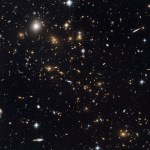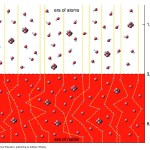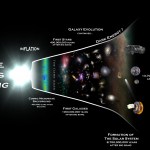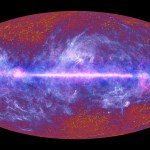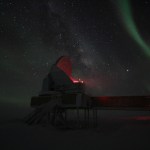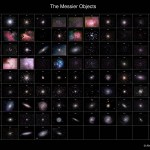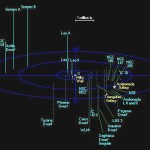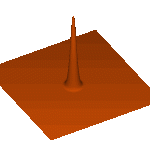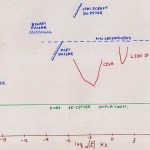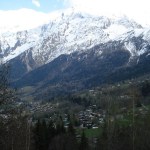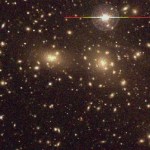CMB
Simon White Director of Max Planck Institut für Astrophysik giving today's Physics Colloquium at ACP on the Planck Results
Likely to be interesting, hence the semi-liveblog.
Starts with description of the collaboration and historical perspective; Penzias and Wilson, COBE and WMAP
Cute ESA video showing Planck science
Even better ESA video explaining stuff
Very good description of baryon acoustic oscillations and polarization.
Quick glimpse of stacked and normalized Planck measurements of tangential/radial polarization of cold/hot spots at ~ 1 degree scales.
Nice animation blinking weak…
"Science cannot tell theology how to construct a doctrine of creation, but you can't construct a doctrine of creation without taking account of the age of the universe and the evolutionary character of cosmic history." -John Polkinghorne
Out there in space, whether we look with our eyes or with a telescope -- a far more powerful version of our eyes -- we find that the Universe is full of stars, galaxies, clusters, and luminous objects everywhere we look.
Image credit: Rogelio Bernal Andreo of http://www.deepskycolors.com/.
But if we look in different wavelengths of light than what our eyes…
"Twinkle, twinkle, quasi-star
Biggest puzzle from afar
How unlike the other ones
Brighter than a billion suns
Twinkle, twinkle, quasi-star
How I wonder what you are." -George Gamow
The Big Bang is one of the greatest, revolutionary ideas in all of modern science, but it's also one of the most successful ideas as far as making predictions that have aligned with our observations of the Universe. Despite all of that, there are a whole bunch of people who'll read this (and more who won't) who aren't sure that the Big Bang is correct. Some people, in fact, don't even understand the definition…
“Because dark energy makes up about 70 percent of the content of the universe, it dominates over the matter content. That means dark energy will govern expansion and, ultimately, determine the fate of the universe.” -Eric Linder
It's been a while since we've spoken about dark energy, and we were just talking about Einstein's greatest blunder, so let's just dive right in.
Image credit: S. Beckwith & the HUDF Working Group (STScI), HST, ESA, NASA.
This is our observable Universe, as unveiled by the Hubble Space Telescope. With hundreds of billions of galaxies stretched out some 41…
"The radiation left over from the Big Bang is the same as that in your microwave oven but very much less powerful. It would heat your pizza only to -271.3°C, not much good for defrosting the pizza, let alone cooking it." -Stephen Hawking
One of the most powerful predictions of the Big Bang -- the fact that our cold, star-and-galaxy-rich, slowly-expanding Universe came from a hot, dense, much more homogeneous state -- was the existence of a bath of leftover radiation that should be detectable, even today.
Image credit: Pearson / Addison Wesley, retrieved from Jill Bechtold.
Back when the…
"Much later, when I discussed the problem with Einstein, he remarked that the introduction of the cosmological term was the biggest blunder he ever made in his life. But this “blunder,” rejected by Einstein, is still sometimes used by cosmologists even today, and the cosmological constant denoted by the Greek letter Λ rears its ugly head again and again and again." -George Gamow, the father of the Big Bang model
The Big Bang -- the prediction that the Universe started from a hot, dense, rapidly expanding state -- tells us where our cold, star-and-galaxy-rich, slowly expanding Universe full of…
"Scientific discovery and scientific knowledge have been achieved only by those who have gone in pursuit of it without any practical purpose whatsoever in view." -Max Planck
Tomorrow morning, at 8 AM my time, the press conference that cosmologists have spent the past decade waiting for will finally happen, and the Planck satellite -- the most powerful satellite ever to measure the leftover radiation from the Big Bang -- will finally unveil its results about the origin and composition of the Universe.
Image credit: ESA / LFI and HFI Consortia.
They've figured out how to subtract the…
"A cosmic mystery of immense proportions, once seemingly on the verge of solution, has deepened and left astronomers and astrophysicists more baffled than ever. The crux ... is that the vast majority of the mass of the universe seems to be missing." -William J. Broad
Despite the wondrous, luminous sights of the night sky, we've learned that normal matter -- protons, neutrons, electrons and the like -- make up only 4% of the total energy in the Universe.
Image credit: Large Suite of Dark Matter Simulations (LasDamas) simulation; Vanderbilt.
The galaxies and clusters of galaxies lighting up…
"It took less than an hour to make the atoms, a few hundred million years to make the stars and planets, but five billion years to make man!" -George Gamow
Earlier today, a video (from last month) was released where one of the members of the US House of Representative -- a member who sits on the House Committee for Science, Space and Technology -- proudly proclaimed the following:
"All that stuff I was taught about evolution, embryology, the big bang theory; all of that is lies straight from the pit of hell." -Paul Broun
Well, if the Big Bang is a lie from the pit of hell, then the…
Some of you who've been following astronomy for awhile might remember this report, where a group of astronomers reported finding a giant "void" in the Universe.
What is a void? Well, galaxies are distributed pretty randomly, but because of gravity, they cluster together. A small example is our local group which looks like this,
and a larger example is the Virgo cluster, which is about 1,000 times as massive as our local group, and looks like this:
Well, a void is the opposite of a cluster, where you have a large volume of space that's simply empty of galaxies and matter. This press release…
So as a full member of both the American Astronomical Society and the American Physical Society, I get sent issues of the magazine Physics Today. Well, I was going through the April issue, when I saw this article:
Cosmic Sound Waves Rule
by Daniel J. Eisenstein and Charles L. Bennett
That first name sounds familiar. Why? Because he's my boss! The article requires a subscription, but seeing as how this is what my research is, why don't I tell you what the big idea is.
The Universe is full of dark matter, normal matter, and radiation. When it's young, the radiation is more important than matter…
Nothing gets past you, does it? A scientific paper came out earlier this week, and I took a look at it, sighed, and Jamie asked me, "What?" And I said to her, "When I see bad science, it just makes me a little bit frustrated and sad." Of course, I had no intention to write about it.
But then Starts With A Bang reader Matt emailed me, and writes the following about this press release that he had seen:
You have two explanations for these gravitational waves now and that much I understand. But they make it sound as if symmetry breaking and inflation are competing theories. They aren't, right? Do…
Two summers ago, I was in Les Houches, France, for a summer school that turned out to be one of the best experiences of my life. Seriously, we'd wake up every day and this was the view from the school:
Well, the University/Institution that ran the school sends periodic updates to me. And they linked me to this release. Here's the interesting and (if it's true) sensational claim that the release makes:
Recently, a team of theorists ... performed a new analysis of all available CMB and LSS data including the WMAP and Sloan data and favor an inflation model where exist primordial gravitational…
Last week, Pamela Gay over at Star Stryder pointed me to a press release which claimed that, among other things, perhaps dark matter wasn't necessary. So I wrote a guest post on her blog explaining why it was. Apparently, some people still aren't convinced. So I will lay out for you all the reasons I can think of why we need it, and explain what happens if you try to do without it.
1. Cluster Velocity Dispersions. When we take a look at galaxies, we often find hundreds or even thousands of them clustered together, like in the Coma Cluster. We can measure how quickly those galaxies are moving…


